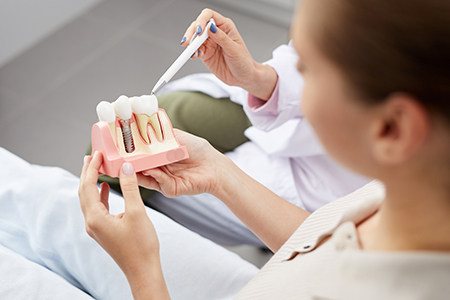
Our Office
Visit Us Online

Missing teeth affect more than appearance — they influence comfort, nutrition, and the way your jaw ages over time. Dental implants offer a predictable way to replace lost teeth with results that look and function more like the real thing than ever before. Modern implant dentistry combines precise planning with durable materials, giving patients long-term solutions that support oral health and everyday life.

At Towne Dental & Orthodontics, we emphasize restoring the whole oral environment — not just filling a gap. By treating the tooth root as well as the visible crown, implants preserve the surrounding bone and provide the stable foundation needed for comfortable chewing, clear speech, and a confident smile. Patients commonly report greater ease speaking and eating compared with removable solutions.
Implants are anchored into the jawbone and function similarly to tooth roots. This connection transmits chewing forces to the bone, which helps maintain bone volume and facial structure. Because implants are fixed and supported by bone, they eliminate many of the fit and slippage issues associated with removable dentures.
Successful implant treatment depends on a biological process called osseointegration — the direct bonding of bone to the implant surface. That bond is what allows an implant to become a long-lasting support for crowns, bridges, or overdentures. Advances in implant surface design and imaging have steadily improved predictability and healing times.
Before any surgical step, thorough diagnostics guide treatment. Digital X-rays and three-dimensional imaging let clinicians assess bone volume, nerve locations, and sinus anatomy so implants are placed precisely where they will perform best. Careful planning reduces surprises during surgery and supports better long-term outcomes.
Implant systems come in various diameters and lengths to match different clinical situations. When paired with high-quality restorative materials, they provide durable function and cosmetics that blend naturally with adjacent teeth. The combination of planning, implant selection, and skilled restoration is what makes implant therapy reliable.
While designs vary, most systems have the same basic elements: the implant body (the portion placed in bone), an abutment that connects the implant to the visible restoration, and the final crown, bridge, or denture. Each piece is chosen to suit the specific clinical need, from single-tooth gaps to full-arch replacements.
Implant dentistry is adaptable: whether you’ve lost a single tooth or need a full-arch restoration, there are implant-based options that prioritize function and esthetics. These approaches aim to minimize impact on remaining teeth while restoring chewing efficiency and speech clarity.
Implant care begins with a comprehensive exam and individualized plan. We evaluate your oral and medical history, examine the bite, and use imaging to map the jaw. The goal is to design treatment that aligns with your health, functional needs, and cosmetic expectations while minimizing risk.
Surgical placement of implants is generally an outpatient procedure. Many patients experience minimal discomfort because the surgery is concentrated and performed under local anesthesia, with sedation options available for those who prefer them. Post-op instructions and follow-up visits help manage healing and ensure predictable integration.
In some situations, temporary restorations can be attached immediately after implant placement, allowing patients to maintain appearance and some function during healing. In other cases, a period of healing is recommended before fabricating the final restoration to ensure a stable foundation and the best long-term result.
Not every jaw has sufficient bone for implants initially. When bone volume is inadequate, bone grafting or sinus lift procedures can rebuild support so implants can be placed successfully. These techniques are common and often predictable, allowing more patients to benefit from implants than in the past.
Long-term success relies on both clinical excellence and consistent home care. Just like natural teeth, implant restorations require daily cleaning and regular professional checkups. Routine examinations let the dental team monitor gum health, bone levels, and the condition of restorations to catch issues early.
Peri-implant tissues need attention because inflammation around an implant can threaten bone support. Gentle cleaning, proper flossing or interdental brushes, and periodic professional maintenance help preserve the tissues that support the implant. Clinicians can recommend personalized hygiene strategies based on your individual needs.
Most implant restorations are durable, but restorations can wear over long periods and may require replacement or adjustment. Regular follow-up appointments allow us to refine bite relationships and polish or replace parts as necessary to keep your implant functioning smoothly for years to come.
Implant survival rates are high when treatment is planned and executed correctly. Factors such as overall health, smoking, and uncontrolled periodontal disease can influence outcomes, which is why a thorough evaluation and a tailored care plan are essential before moving forward.
Choosing implant therapy is a decision about restoring not only teeth but quality of life. With careful assessment, precise placement, and long-term maintenance, implants can provide a stable, natural-feeling solution for many patients. We focus on clear communication so you understand each phase of care and what results to expect.
Our team blends technology with practical experience to deliver restorative solutions that prioritize both function and aesthetics. If you’re exploring options to replace missing teeth, we’ll walk you through the process, review imaging, and outline realistic pathways tailored to your oral health and goals.
Contact us to learn more about how implant dentistry can rebuild your smile and improve daily comfort. Our team is available to answer questions and explain the next steps toward a treatment plan that fits your needs.
If you've lost a tooth due to injury, decay, gum disease, or any other reason, we recommend dental implants to replace missing teeth. Dental implants come the closest to replicating the look, feel, and function of your natural teeth.
Dental implants are placed into the jawbone and mirror the same function as the root of a tooth. The procedure for dental implants is usually performed while a patient is sedated. Patients who undergo IV sedation must have an empty stomach and transportation home following the procedure. Most sedation patients will have little to no memory of the procedure occurring.
Generally, dental implants are made out of a biocompatible metal such as titanium. Biocompatible metals are also used for other common bone implants (such as shoulder, hip, and knee replacements). The visible portion of the implant is usually made out of porcelain and is custom-made to match your existing teeth.
Dental implants are designed to fuse to the bone, which makes them become permanent fixtures. Typically speaking, the success rate is nearly 100%. There are few cases in which the implant will not fuse as intended and must be removed. If this happens to occur, the procedure can be attempted again a few months later.
Dental implants are not usually covered by dental insurance, but may be covered under a patient's medical insurance. Our office and your insurance company can discuss coverage options with you based on your individual case and treatment plan.
It's easy... just take care of an implant as if it's a natural tooth! This involves regular brushing, flossing, and dental checkups. If you have any concerns about your implant, contact us immediately.
Dental implants are medical-grade titanium posts that are surgically placed into the jawbone to serve as artificial tooth roots. An abutment connects the implant to a custom-made restoration such as a crown, bridge, or overdenture, providing a stable and natural-feeling replacement. Because implants integrate with bone, they restore chewing function and help maintain facial structure.
Implant restorations are designed to match the color, shape, and proportion of surrounding teeth so they blend esthetically and functionally into the mouth. The combination of an implant body, an abutment, and a final restoration creates a durable system that supports normal speech, eating, and oral hygiene. Over time, implants transmit normal chewing forces to bone, which helps preserve jaw volume compared with removable options.
Good candidates for dental implants are generally adults with healthy oral tissues and adequate jawbone to support the implant. The evaluation considers overall health, gum condition, and habits such as smoking; patients with uncontrolled periodontal disease or certain medical conditions may need additional care before implants are placed. A comprehensive exam and imaging are used to confirm whether bone volume and anatomical features are suitable for implant placement.
When jawbone is insufficient, many patients become candidates after bone grafting or sinus augmentation rebuilds support for an implant. Medications, systemic conditions, and past dental history are reviewed to create a safe, individualized treatment plan. The goal is to address any oral health issues first so the implant can integrate predictably and be maintained long term.
Implant treatment begins with diagnostic imaging and a thorough clinical exam to map the jaw, locate nerves and sinuses, and measure bone volume. Digital X-rays and three-dimensional imaging allow clinicians to plan implant position precisely and, when appropriate, fabricate surgical guides to improve accuracy. The planning stage also determines the size and type of implant and whether adjunctive procedures like grafting are needed.
Surgical placement is commonly an outpatient procedure performed under local anesthesia with sedation options available for patient comfort. The implant is inserted into the prepared bone and allowed time to osseointegrate, although some cases permit temporary restorations immediately after placement. Follow-up visits track healing and guide fabrication of the definitive restoration when the implant has achieved stable integration.
After implant surgery patients typically experience mild to moderate swelling and discomfort that peaks within the first 48 hours and subsides over several days. Pain is commonly managed with prescribed or over-the-counter medications and by following post-operative instructions such as cold packs, gentle oral hygiene, and a soft diet. Most patients resume normal activities within a few days, while full integration of the implant can take several weeks to months depending on the situation.
Follow-up appointments are important to monitor healing, remove sutures if needed, and confirm integration before placing the final restoration. Patients are advised to avoid smoking and to maintain excellent oral hygiene during the healing phase to reduce the risk of infection or impaired bone healing. If a temporary prosthesis is provided, the team will explain care instructions to protect the surgical site while preserving appearance and function.
Immediate restorations are provisional crowns or bridges attached to implants at the time of placement or shortly thereafter, which can preserve appearance and some function during healing. These are appropriate when initial implant stability is high and occlusal forces can be controlled, but they may not be suitable in all clinical scenarios. Immediate loading can shorten the treatment timeline for select patients while requiring careful case selection and follow-up.
Delayed restorations allow a healing period for osseointegration before the final prosthesis is fabricated, which can offer a predictable foundation for long-term success. This approach is commonly used when bone quality or primary stability is less certain, or when additional grafting procedures are involved. Your clinician will recommend the timing that best balances esthetics, function, and the likelihood of stable integration.
Bone grafting or sinus lift procedures are used when there is insufficient bone volume or height to support a dental implant safely. Bone loss can result from long-term tooth absence, periodontal disease, trauma, or natural anatomical variations, and grafting rebuilds the foundation needed for implant placement. A sinus lift specifically raises the sinus floor and places bone material when the upper back jaw lacks adequate vertical height.
These procedures can be performed before or at the time of implant placement depending on clinical factors and the amount of augmentation required. Modern grafting materials and techniques are predictable and often integrate well with existing bone, enabling more patients to receive implants. Your treatment plan will outline the sequence and healing expectations if grafting is recommended.
Dental implants have a high long-term success rate when placed and maintained properly, often lasting many decades or a lifetime with appropriate care. Success depends on factors such as surgical technique, bone quality, the health of the surrounding gums, and the design of the final restoration. Patient-related factors like smoking, uncontrolled diabetes, and poor oral hygiene can increase the risk of complications and affect longevity.
Regular professional maintenance and timely attention to any changes in comfort or function help preserve implant health over time. Restorative components such as crowns may wear and require replacement, but the implant fixture itself can remain stable when peri-implant tissues are healthy. Ongoing monitoring of bone levels and gum condition is an important part of long-term implant care.
Daily home care for an implant closely resembles that for natural teeth and includes brushing twice a day with a soft-bristled brush and cleaning between teeth with floss or interdental brushes. Patients should use nonabrasive toothpaste and take care around the implant-abutment interface to prevent plaque buildup that can lead to inflammation. Consistent removal of plaque and food debris is essential to protect the soft tissues that support the implant.
In addition to home care, routine professional cleanings and periodontal evaluations help detect early signs of peri-implant inflammation or restoration wear. Your dental team will recommend specific tools and techniques tailored to your restoration type and individual anatomy. Promptly reporting tenderness, swelling, or changes in bite allows the clinician to intervene before minor issues become more serious.
While dental implants are a well-established treatment, potential risks include infection at the surgical site, poor osseointegration, nerve injury, sinus complications, and peri-implantitis, which is inflammation around the implant. Surgical planning and imaging significantly reduce the likelihood of anatomical complications by identifying nerve pathways and sinus locations in advance. Early recognition and treatment of inflammation or infection are important to protect bone support and implant stability.
Careful case selection, attention to medical history, and adherence to post-operative instructions lower the chance of adverse outcomes. Long-term monitoring by the dental team and good oral hygiene at home are the primary defenses against many complications. If concerns arise, conservative measures or targeted therapies can often resolve problems without losing the implant.
Towne Dental & Orthodontics begins implant care with a comprehensive exam that includes a review of medical history, clinical evaluation, and digital imaging to map bone anatomy and plan implant placement precisely. The practice emphasizes individualized treatment plans that consider functional needs, esthetic goals, and the health of surrounding teeth and gums. Technology such as three-dimensional imaging and digital planning tools helps the team anticipate anatomic challenges and optimize implant position.
Throughout the process the team discusses the realistic timeline, recommended adjunctive procedures if needed, and post-operative care to support long-term success. Coordination between surgical and restorative phases ensures the final prosthesis functions comfortably and blends with adjacent teeth. Patients receive clear instructions for healing and maintenance so they can actively participate in preserving their implant over time.